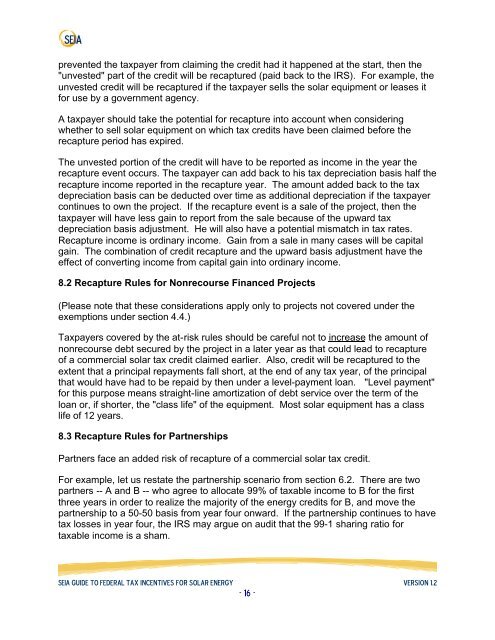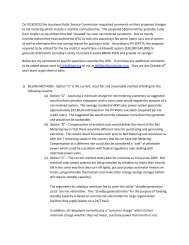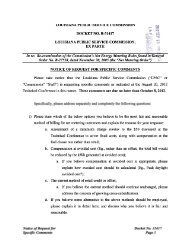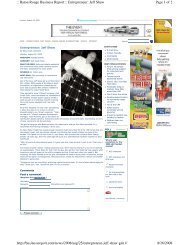SEIA Guide to Federal Tax Incentives for Solar Energy - Solar Power ...
SEIA Guide to Federal Tax Incentives for Solar Energy - Solar Power ...
SEIA Guide to Federal Tax Incentives for Solar Energy - Solar Power ...
You also want an ePaper? Increase the reach of your titles
YUMPU automatically turns print PDFs into web optimized ePapers that Google loves.
prevented the taxpayer from claiming the credit had it happened at the start, then the"unvested" part of the credit will be recaptured (paid back <strong>to</strong> the IRS). For example, theunvested credit will be recaptured if the taxpayer sells the solar equipment or leases it<strong>for</strong> use by a government agency.A taxpayer should take the potential <strong>for</strong> recapture in<strong>to</strong> account when consideringwhether <strong>to</strong> sell solar equipment on which tax credits have been claimed be<strong>for</strong>e therecapture period has expired.The unvested portion of the credit will have <strong>to</strong> be reported as income in the year therecapture event occurs. The taxpayer can add back <strong>to</strong> his tax depreciation basis half therecapture income reported in the recapture year. The amount added back <strong>to</strong> the taxdepreciation basis can be deducted over time as additional depreciation if the taxpayercontinues <strong>to</strong> own the project. If the recapture event is a sale of the project, then thetaxpayer will have less gain <strong>to</strong> report from the sale because of the upward taxdepreciation basis adjustment. He will also have a potential mismatch in tax rates.Recapture income is ordinary income. Gain from a sale in many cases will be capitalgain. The combination of credit recapture and the upward basis adjustment have theeffect of converting income from capital gain in<strong>to</strong> ordinary income.8.2 Recapture Rules <strong>for</strong> Nonrecourse Financed Projects(Please note that these considerations apply only <strong>to</strong> projects not covered under theexemptions under section 4.4.)<strong>Tax</strong>payers covered by the at-risk rules should be careful not <strong>to</strong> increase the amount ofnonrecourse debt secured by the project in a later year as that could lead <strong>to</strong> recaptureof a commercial solar tax credit claimed earlier. Also, credit will be recaptured <strong>to</strong> theextent that a principal repayments fall short, at the end of any tax year, of the principalthat would have had <strong>to</strong> be repaid by then under a level-payment loan. "Level payment"<strong>for</strong> this purpose means straight-line amortization of debt service over the term of theloan or, if shorter, the "class life" of the equipment. Most solar equipment has a classlife of 12 years.8.3 Recapture Rules <strong>for</strong> PartnershipsPartners face an added risk of recapture of a commercial solar tax credit.For example, let us restate the partnership scenario from section 6.2. There are twopartners -- A and B -- who agree <strong>to</strong> allocate 99% of taxable income <strong>to</strong> B <strong>for</strong> the firstthree years in order <strong>to</strong> realize the majority of the energy credits <strong>for</strong> B, and move thepartnership <strong>to</strong> a 50-50 basis from year four onward. If the partnership continues <strong>to</strong> havetax losses in year four, the IRS may argue on audit that the 99-1 sharing ratio <strong>for</strong>taxable income is a sham.<strong>SEIA</strong> <strong>Guide</strong> <strong>to</strong> <strong>Federal</strong> <strong>Tax</strong> <strong>Incentives</strong> <strong>for</strong> <strong>Solar</strong> <strong>Energy</strong> Version 1.2- 16 -






